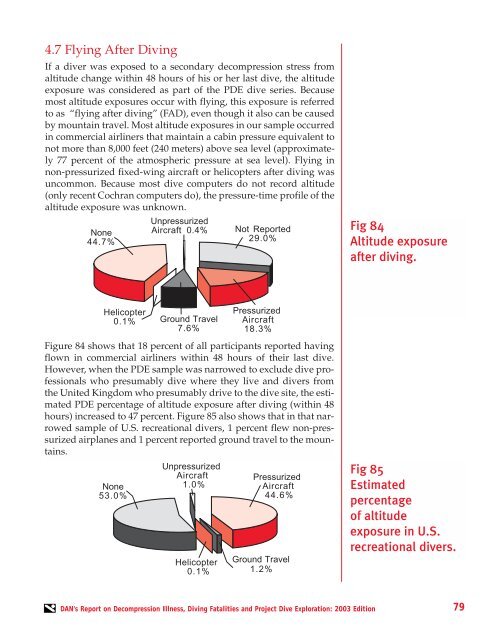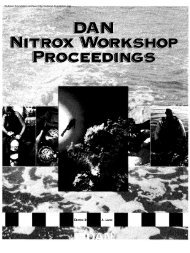Report on Decompression Illness, Diving Fatalities - Divers Alert ...
Report on Decompression Illness, Diving Fatalities - Divers Alert ...
Report on Decompression Illness, Diving Fatalities - Divers Alert ...
You also want an ePaper? Increase the reach of your titles
YUMPU automatically turns print PDFs into web optimized ePapers that Google loves.
4.7 Flying After <strong>Diving</strong>If a diver was exposed to a sec<strong>on</strong>dary decompressi<strong>on</strong> stress fromaltitude change within 48 hours of his or her last dive, the altitudeexposure was c<strong>on</strong>sidered as part of the PDE dive series. Becausemost altitude exposures occur with flying, this exposure is referredto as “flying after diving” (FAD), even though it also can be causedby mountain travel. Most altitude exposures in our sample occurredin commercial airliners that maintain a cabin pressure equivalent t<strong>on</strong>ot more than 8,000 feet (240 meters) above sea level (approximately77 percent of the atmospheric pressure at sea level). Flying inn<strong>on</strong>-pressurized fixed-wing aircraft or helicopters after diving wasuncomm<strong>on</strong>. Because most dive computers do not record altitude(<strong>on</strong>ly recent Cochran computers do), the pressure-time profile of thealtitude exposure was unknown.N<strong>on</strong>e44.7%UnpressurizedAircraft 0.4%Not <str<strong>on</strong>g>Report</str<strong>on</strong>g>ed29.0%Fig 84Altitude exposureafter diving.Helicopter0.1%PressurizedAircraft18.3%Figure 84 shows that 18 percent of all participants reported havingflown in commercial airliners within 48 hours of their last dive.However, when the PDE sample was narrowed to exclude dive professi<strong>on</strong>alswho presumably dive where they live and divers fromthe United Kingdom who presumably drive to the dive site, the estimatedPDE percentage of altitude exposure after diving (within 48hours) increased to 47 percent. Figure 85 also shows that in that narrowedsample of U.S. recreati<strong>on</strong>al divers, 1 percent flew n<strong>on</strong>-pressurizedairplanes and 1 percent reported ground travel to the mountains.N<strong>on</strong>e53.0%Ground Travel7.6%UnpressurizedAircraft1.0%Helicopter0.1%PressurizedAircraft44.6%Ground Travel1.2%Fig 85Estimatedpercentageof altitudeexposure in U.S.recreati<strong>on</strong>al divers.DAN’s <str<strong>on</strong>g>Report</str<strong>on</strong>g> <strong>on</strong> Decompressi<strong>on</strong> <strong>Illness</strong>, <strong>Diving</strong> <strong>Fatalities</strong> and Project Dive Explorati<strong>on</strong>: 2003 Editi<strong>on</strong> 79
















